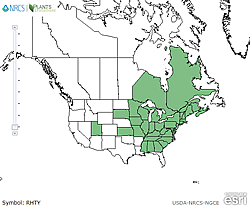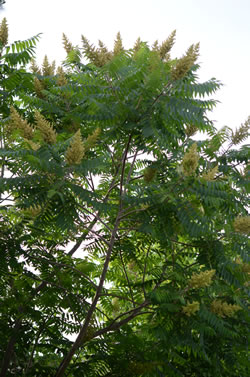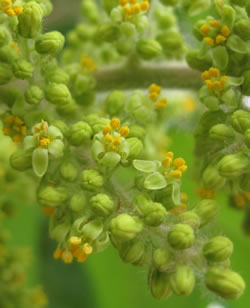Plant of the Week
 Rhus typhina range map. USDA PLANTS Database.
Rhus typhina range map. USDA PLANTS Database.
 Small tree with flowers. Photo by David Taylor.
Small tree with flowers. Photo by David Taylor.
 Staghorn sumac (Rhus typhina). USDA-NRCS PLANTS Database / Herman, D.E., et al. 1996. North Dakota tree handbook. USDA NRCS ND State Soil Conservation Committee; NDSU Extension and Western Area Power Administration, Bismarck.
Staghorn sumac (Rhus typhina). USDA-NRCS PLANTS Database / Herman, D.E., et al. 1996. North Dakota tree handbook. USDA NRCS ND State Soil Conservation Committee; NDSU Extension and Western Area Power Administration, Bismarck.
 Panicle of flowers. Photo by David Taylor.
Panicle of flowers. Photo by David Taylor.
Staghorn Sumac (Rhus typhina)
By David Taylor
Staghorn Sumac is a member of the Anacardiaceae, the Sumac or Cashew family. Species in this family range from medium-sized trees to herbs a few inches high. Species of economic importance or medical concern found in the family include cashew (Anacardium occidentale), mango (Mangifera indica), pistachio (Pistacia vera), poison ivy (Toxicodendron radicans), and Pacific poison oak (Toxicodendron diversilobium). There about 150 species of sumac worldwide and 14 species native to the United States.
This sumac is 1 to 10 meters (ca. 3 to 33 feet) tall, usually tree-like, but in thickets, and occasionally shrubby. It is strongly rhizomatous. The stem may reach 25 centimeters (ca. 10 inches) diameter. Twigs are stout, densely red hairy and 16 to 20 millimeters (5/8 to 3/4 inches) thick (see photo). Leaves are alternate and pinnately compound, 20 to 40 centimeters (ca. 6 to 16 inches) long by 10 to 18 centimeters (ca. 4 to 7 inches) wide. Each leaf has 11 to 31 coarsely toothed leaflets, green on top, and much paler underneath. Flowers are borne in clusters (panicles) of hundreds to thousands of flowers at the tips of branches. Flower clusters are up to 20 centimeters (ca. 8 inches) long and 5 to 10 centimeters (2 to 4 inches) across (see photo). Yellow to greenish, 5-petaled flowers are small, only about 3 millimeters (about 1/8 inches) wide (see photo). Fruits are fuzzy, bright red to brownish-red, 1-seeded drupes (like a cherry or peach) about 4 millimeters (1/6 inches) across.
Staghorn sumac is an open land species often found on drier soils, but which may occasionally occur on low ground. It is a species of prairies and other grasslands, old fields, roadsides, savannas and woodlands, and fencerows. It is found from New England south to Georgia west to Michigan, Iowa, Missouri and Mississippi. It also occurs in South Dakota, Kansas and Utah. In Canada it occurs from Nova Scotia west to Ontario.
This species flowers in June to July depending on the part of the country in which it is found. Bees, wasps, and beetles are strongly attracted to the flowers. Some bird and small mammal species eat the fruits. The fruits are sometimes soaked in water to make a tart, somewhat lemony drink. It is occasionally cultivated for its bright red to maroon fall color and persistent red fruits. Numerous lacey leaf cultivars exist. Without attention, it can become weedy.



